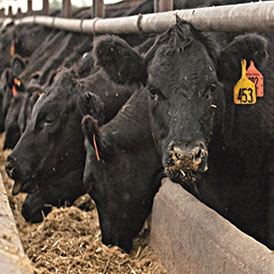Low-stress Stockmanship
Benefits the Feedyard
Cattlemen can control stockmanship, affect cattle performance.
"Quite simply, stockmanship is a requirement for a sustainable future,” said Anne Burkholder, owner of Will Feed Inc., Cozad, Neb. Her No. 1 job is to serve as an animal caregiver and to minimize stress on calves, which allows them to convert finite resources into more gain in the feedyard.
Coming from a non-ag background, she shared with attendees of the Range Beef Cow Symposium in November that her business plan is a reflection of herself, and it is different than that of her father-in-law, who preceded her in feedyard ownership. Her feedyard has vertical collaboration to reduce stress and improve product quality and efficiency. She traces vaccination and health history on incoming cattle, which she buys through private treaty to build relationships and ease transportation stress. She uses professional veterinary and nutritional consultants.
She also uses careful bunk-reading techniques and delivers feed in a timely fashion. They make sure all home pens are clean and comfortable. This business plan may not make the operation more money, but everyone is happier at the end of the day, she noted. Some of her employees were skeptical on low-stress stockmanship, but are now all firm believers.
She acclimates all cattle and all of her staff members (and daughters) use low-stress animal-handling techniques. She strongly supports acclimation for new cattle to the feedyard, saying it teaches the cattle to recognize the home pen is where they want to be. It teaches cattle to walk in straight lines, to exit the home pen and to travel with confidence down the alleyway and into the corral. Cattle gravitate toward the feedbunk and water when they are acclimated, thus going on feed more quickly and smoothly.
| Table 1: Traits that low-stress stockmanship affects | |
| Morbidity | |
| Mortality | |
| Feed conversion | |
| Carcass quality | |
| Food safety | |
| Worker safety | |
Additionally, it enables safer, more effective handler-animal interactions. More comfortable cattle equal more efficient feed conversion and higher-quality beef, she asserted. Acclimated cattle are quieter and easier to handle, thus making the daily workload more enjoyable.
Burkholder shared five lessons she’s learned from her cattle.
- 1. Proper preconditioning is vital to animal performance.
- 2. A calf must be bred with an innate desire to live and be phenotypically capable of staying healthy all the way to the packing plant.
- 3. Limiting stress is critical for both calf health and performance. To effectively limit stress, cattle caregivers must work together to continuously meet the needs of the calf.
- 4. Cattle’s past experiences help determine the future.
- 5. It is the little things that count. Paying attention to detail when caring for a prey animal is a critical component for success. Learn to “think like a calf” to set it up for success, because the calf can’t think like you.
Stockmanship really shows its benefit at the packing plant, she added.
Low-stress stockmanship is something that cattlemen can control, she concluded, and it affects morbidity, mortality, feed conversion, carcass quality, food safety and worker safety.
Editor’s Note: This summary is part of the Angus Journal’s online coverage of the 2015 Range Beef Cow Symposium Nov. 17-19, 2015, in Loveland, Colo. For additional coverage, to review this presentation’s PowerPoint or to listen to the presentation, visit the Newsroom at www.rangebeefcow.com. The Angus Journal’s coverage of the event is made possible through collaboration with the event committee and sponsorship of LiveAuctions.tv.








